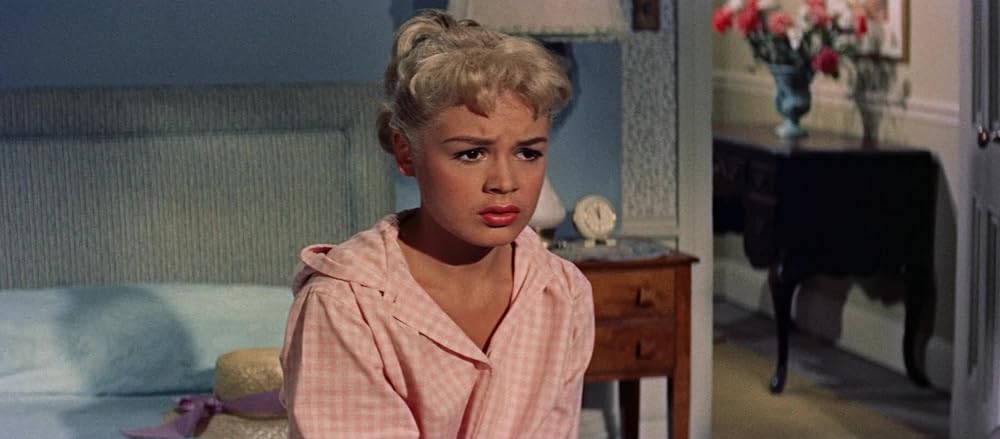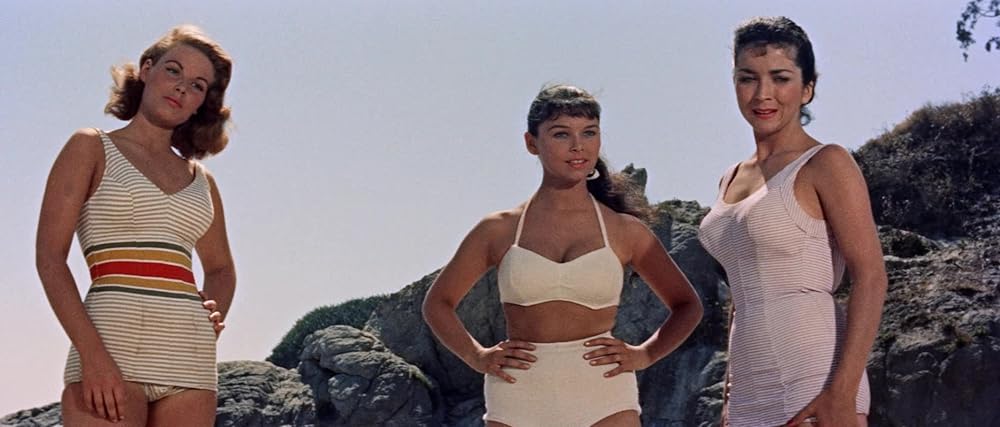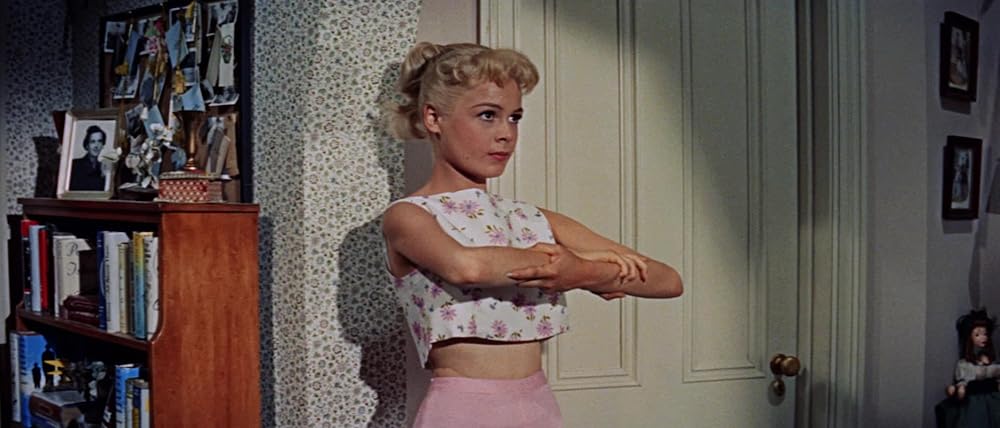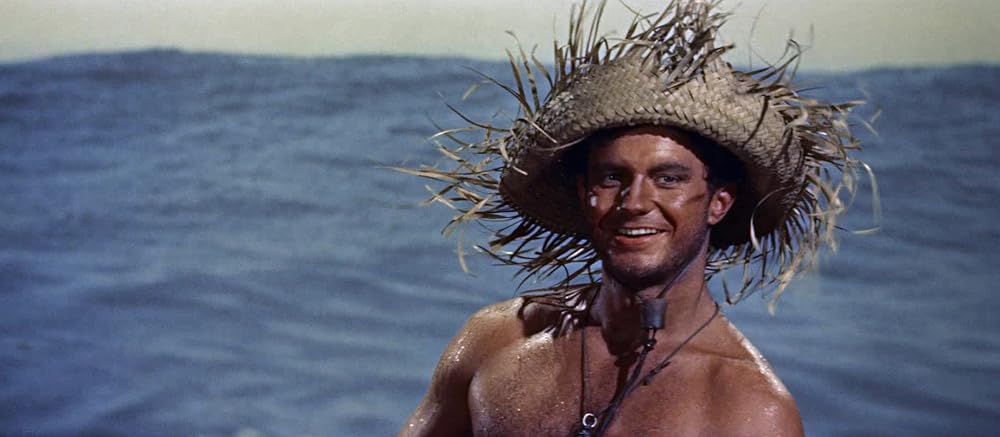|Penny Folger|

Gidget plays at the Trylon Cinema from Friday, February 9th, through Sunday, February 11th. Visit trylon.org for tickets and more information.
Gidget. What springs to mind for people when they hear this name, that is, if in 2024 they still know the reference? The beach? Actors surfing in front of a green screen? Maybe Sally Field?
Gidget, from 1959 as directed by Paul Wendkos and starring Sandra Dee, is the first representation of Gidget on screen. The character originates from a series of novels by screenwriter Frederick Kohner, a Czechoslovakian Jew who fled the German film industry for Hollywood in 1933. Kohner was working for Columbia Pictures when he started writing novels on the side based on his teenage daughter, who was becoming involved in Southern California’s surf culture. Weaving together stories she had told him, he wrote the first Gidget novel in six weeks.
The subsequent film was a big hit, inspiring two more movies, a successful television series starring Sally Field, several television movies, and an eventual television reboot in the 1980s. I grew up seeing reruns of the original TV series in syndication as a small child, and while I don’t have an adult perspective on that, nor have I had the opportunity to read the original novel, the movie is filled with all kinds of odd messaging that Gidget’s (who seems like the most reasonable, sane character on screen) head is being filled with.

Gidget’s friends devalue her scholastic and musical achievements, like they are a waste of time in the pursuit of “hunting” men. They’re socially segregated from the boys, yet their activities seem planned solely with them in mind. They play ritualistic games, making a big show of undressing on the beach so they can prance around in their swimsuits past the boys’ camp while pretending not to notice them. They throw a ball in their direction, in the hopes that it will be returned to them. Their ploys, at least in this instance, do not work.
When Gidget takes her cover-up off after the other girls do, we hear a musical “womp-womp,” as though the film itself is making fun of her small stature. When giving her a surf lesson her instructor, who is one of the boys, suddenly exclaims, “Flat as a pancake, huh? Well, almost anyway,” and looks as if he’s about to spank her but withdraws his hand at the last second. It’s unclear at first if he means her or the surfboard, though subtext suggests it’s the former. Later on, she does “exercises” in an attempt to increase the volume of her bust, in the hopes that she’ll be invited to the surfers’ big luau: as though an invite is completely contingent on her measurements being “up to snuff.”

In reality, Dee is, of course, totally adorable. That she is tiny, aside from age and genetics, is the result of her severe life-long battle with anorexia, which was already well underway at that time. But she was also quite young. Dee developed early and her mother lied about her age when she entered the business in order to secure work. According to Dee’s son she was born in 1944, not 1942 as has otherwise been cited. This means she would have been a mere 15 years old upon the film’s release, and not the “turning 17” she portrays here. Much is made of her age in the film. Worries one contemporary early on about Gidget, “And let’s face it, like most of us, she’s pushing 17!” The girl is concerned about Gidget’s lack of apparent sexual conquests thus far, or at least her interest in such things.
Yet Dee’s Gidget is 100% genuinely herself instead of being dishonest about her interests or her intentions. She walks around unselfconsciously in a diving mask, for which the other girls mock her, just wanting to be engaged with the world.
Her attitude towards the boys is also healthy. As she says to the girls after their failed ball retrieval ploy, “Oh come off it kids, those guys just aren’t interested. So who needs ‘em?”
The universe Gidget inhabits makes her erroneously assume that something is wrong with her. She genuinely wants to engage in the boys’ activities (surfing) because they’re exciting, not because she hopes to win their attention. She isn’t feigning interest in order to infiltrate their ranks. She becomes a part of their community organically, as a result of shared interests. The boys’ constant teasing aside, this relationship feels a lot more genuine than one won through game playing. Gidget seems like a healthy person swimming around in an unhealthy world.
The boys in this movie, the two leads anyway, have ridiculous nicknames and seem stunted by their own emotions. “Moondoogie” we later learn is named Jeff and “The Big Kahuna” we find out by movie’s end is really a Burt. They in turn bequeath Gidget, real name Francine, with her nickname. (Are nicknames a dissociative way of not only separating themselves from their birth identity but also cloaking themselves from their own emotions?)
Both male leads seem to want to literally run away. There is talk, mostly on the part of Jeff when speaking privately with Kahuna, about doing so. (I’ll reference this character mostly as “Jeff,” because typing out “Moondoggie” over and over again in reference to him feels increasingly ridiculous.)
Says Jeff to Kahuna conspiratorially, “I tell you, I can hardly wait til we hop that freighter.”
Kahuna who is literally dissociated, stewing as he is in his own emotions, barely answers.
Continues Jeff, “Look, all I’m thinking about is getting on our way to places we’ll see!”
Earlier on Jeff tries Kahuna’s attitude on for size, trying to pass it off as his own, but it’s as though he’s using it as a shield against the world. In one of their early moments together he lectures Gidget, “The way we see it around here, the Kahuna and me, nobody owes anybody anything. Not if they play it smart. Not if they don’t let themselves get involved.”
Jeff seems heavily influenced by Kahuna’s example of what it is to be a “man.” Yet simultaneously Kahuna himself seems increasingly uncertain that his life philosophy of detachment and withdrawal from all responsibility is working out at all. The movie implies it was formed in reaction to his stint and subsequent return from the Korean War. While it’s mentioned by Jeff that Kahuna is twice Gidget’s age, this isn’t wrong. In reality, Cliff Robertson who plays him was 36 years old at the time of the film’s release. James Darren, who plays Jeff, was 23.
What’s interesting here is that the younger characters are all looking up to an older one who’s been disillusioned by war. Kahuna is also interesting because he’s all that is “masculine” with a capital “M.” While yes, the film’s primary location is the beach, even when not in that setting, Kahuna either always has his shirt wide open, or he makes a big show of disrobing his upper body entirely. His chest always looks tan and like it’s been freshly oiled, in a way the other characters’ do not. (One wonders if there was a makeup person especially assigned to this task.) Most comically, he sometimes surfs while casually smoking a cigar, in a way that is reminiscent of George Peppard in The A-Team. It could be said that wears his machismo on his sleeve, if he was ever wearing a shirt.

That the icon of this masculinity is failing, buckling under his own silent emotion and disillusionment mirrors the way that the girl group’s classic femininity is also failing. Gidget’s mother lectures her after Gidget realizes she has feelings for Jeff, “It’s not up to you. It’s up to the young man.” Apparently expressing one’s desire directly is bad, because one should instead wait passively for emotionally crippled men to make a move.
These women are being taught to be passive and game-playing, while their male counterparts aspire to be strong and emotionally avoidant. It’s only Gidget who seems to pierce through this dichotomy. She says what she thinks and goes for what she wants. When she finally tries out the game-playing that’s been pressured and preached into her throughout the film, she winds up in the police station.
At its core, the darkest element of Gidget is the real life of Sandra Dee. Her childhood was like something out of Twin Peaks: after years of sexual abuse at the hands of her stepfather she had lifelong battles with anorexia, alcoholism, and dependency. This was in combination with her mother’s simultaneous codependency and neglect. Dee was cooking meals for herself and riding NY subways alone to go to modeling jobs by age 11. Yet paradoxically she remained a virtual prisoner of her codependent mother until she finally escaped after marrying the singer, Bobby Darin.
Said their son Dodd Darin in his 1994 book about his parents, “My mother’s childhood was a horror story made more unbelievable by the contrast between the public’s image of Sandra Dee—a golden teenage princess—and the truth.”1
Gidget becomes an exercise in watching a teenage girl try to maintain pride in who she is in a world that is backward. Quite tragically, in a real world much darker than the one depicted in this movie, the woman who plays her could not do the same. At least Gidget, viewed by an audience no doubt naive to her real-life struggles, could be inspirational in her courage to be happy in herself in a way that Dee never would. The most lovable thing about Gidget is that despite the ridiculous messaging she receives, she remains intact.
- Darin, Dodd. Dream Lovers: The Magnificent Shattered Lives of Bobby Darin and Sandra Dee—by Their Son Dodd Darin. Warner Books, 1994. ↩︎
Edited by Finn Odum
